Description: This perennial plant is 1½–3' tall and more or less erect. It is usually unbranched below, while branching occasionally above. The stems are light green or light blue, glabrous, and often glaucous; they are usually terete, although sometimes the stems are narrowly furrowed. Alternate leaves occur along the entire length of these stems, becoming gradually smaller in size as they ascend. These leaves are up to 6" long and 1¼" across, although they are typically about one-half of this size. The leaves are oblong-ovate, oblong-obovate, lanceolate, or ovate in shape, while their margins are either entire (toothless) or sparingly and bluntly toothed. Both lower and upper leaves clasp their stems. The upper leaf surface is medium green to grayish blue, glabrous, and sometimes glaucous, while the lower leaf surface is light green or light grayish blue, glabrous, and sometimes glaucous. A reticulated network of secondary veins is usually visible on the lower surface of each leaf.
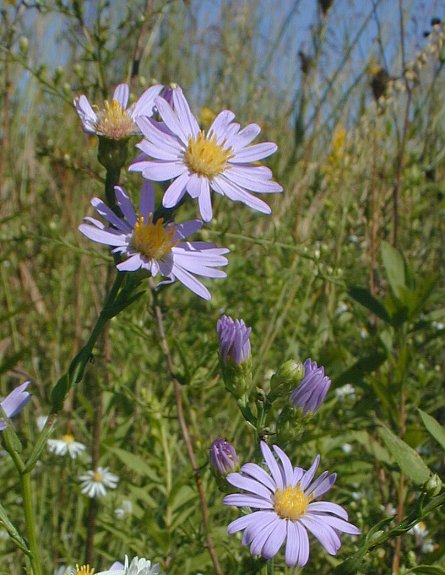
The central stem terminates in a panicle of flowerheads about ½–1' long and about one-half as much across; smaller panicles of flowers often develop from lateral upper stems and the axils of upper leaves. Each flowerhead is ½–1" across, consisting of 15-30 ray florets that surround a dense head of numerous disk florets. The petaloid rays of the flowerheads are light lavender or light blue-violet (rarely white), widely spreading, and narrowly oblong in shape. The corollas of the disk florets are 3-6 mm. long, tubular in shape, and 5-lobed along their upper rims. During the blooming period, they change in color from whitish yellow to purplish red, eventually turning brown afterwards. The short-triangular lobes of these corollas are erect or ascending. Surrounding the base of each flowerhead, there are glabrous phyllaries (floral bracts) in several series that are erect or appressed together; they are linear-oblong in shape or sometimes wider. These phyllaries are mostly light green or light bluish green; they have either dark green markings at their tips or solitary vertical veins that are dark green.
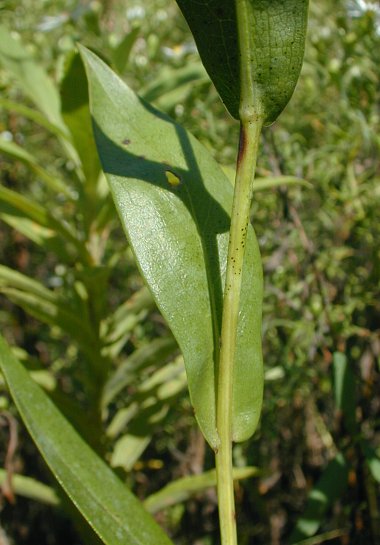
The branches and peduncles of the panicle are light green or light grayish blue, terete, glabrous, and sometimes glaucous; solitary leafy bracts up to 2" long and ½" occur where the branches divide. The characteristics of these leafy bracts are similar to those of the leaves. The blooming period occurs from late summer to early autumn, lasting about 3-4 weeks for a colony of plants. Afterwards, the florets are replaced by achenes with small tufts of tawny (less often white) hair; they are distributed by the wind. Individual achenes are 2-3 mm. long, narrowly oblongoid-oblanceoloid in shape, slightly flattened, and variably colored (usually some shade of gray or brown with whitish fine ribs). The root system is fibrous and rhizomatous; older plants may develop small woody caudices. Occasionally, clonal offsets are produced from the rhizomes.
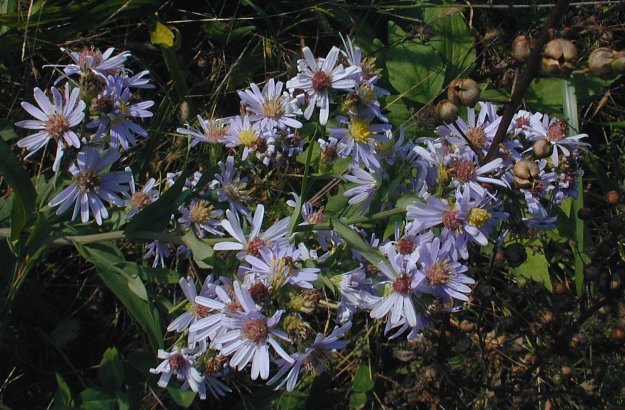
Cultivation:
The preference is full to partial sun, mesic conditions, and soil
containing loam, clay-loam, sandy loam, or some rocky material. This
plant usually remains erect while in bloom and it is able to tolerate
hot dry weather if it is not too prolonged. The foliage is occasional
marred by powdery mildew and other foliar diseases to some extent; good
air circulation reduces this vulnerability. Smooth Blue Aster is easy
to cultivate in gardens if taller and more aggressive plants are kept
away from it.
Range & Habitat:
The native Smooth Blue Aster occurs occasionally in most counties of
Illinois, but it is uncommon or absent in western and SE Illinois (see Distribution
Map).
Habitats include mesic black soil prairies, hill prairies,
savannas, rocky open woodlands, sandy woodlands, woodland edges,
thickets, limestone glades, and roadside embankments. Smooth Blue Aster
is usually found in higher quality natural areas where the original
ground flora is intact. It is sometimes cultivated in gardens because
of its attractive foliage and flowerheads.
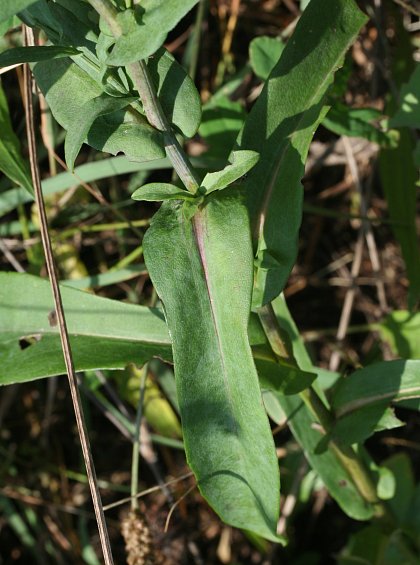
Faunal Associations: The nectar and pollen of the flowerheads attract honeybees, bumblebees, cuckoo bees (Triepeolus spp., Coelioxys spp.), digger bees (Melissodes spp.), leaf-cutting bees (Megachile spp.), Halictid bees (Agapostemon spp., Halictus spp., Lasioglossum spp.), Andrenid bees (including the oligolectic bee, Andrena asteris), Sphecid wasps, Syrphid flies (Eristalis spp., Helophilus spp., Syrphus spp., Toxomerus spp.), Muscid flies, butterflies, and skippers (see Graenicher). Other insects feed destructively on the leaves, flowerheads, and other parts of Smooth Blue Aster (Symphyotrichum laeve) and other asters. These species include a leaf beetle (Ophraella pilosa), the Red-spotted Aster Mirid (Polymerus basalis), larvae of a leaf-mining fly (Nemorimyza posticata), larvae of the Papery Blister Gall Midge (Asteromyia laeviana), the Short-winged Meadow Katydid (Conocephalus brevipennis), caterpillars of such moths as the Wavy-lined Emerald (Synchlora aerata) and The Asteroid (Cucullia asteroides), and Blatchley's Walkingstick (Manomera blatchleyi). The Insect Table and Moth Table list additional insects that feed on this and other asters (Symphyotrichum spp.). Two upland gamebirds, the Ruffed Grouse and Wild Turkey, feed on both the leaves and seeds of asters. The Tree Sparrow and White-footed Mouse also eat the seeds. The young foliage of these plants is browsed occasionally by various mammalian herbivores, including deer, rabbits, groundhogs, horses, cattle, and sheep.
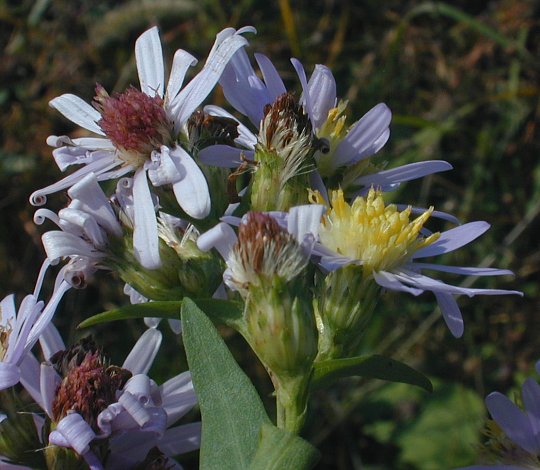
Photographic
Location:
The photographs were taken at a restored prairie of Meadowbrook Park in
Urbana, Illinois, and at a small restored prairie along a drainage
ditch in the same city.
Comments:
Smooth Blue Aster (Symphyotrichum
laeve) has many attractive qualities – they
include its adaptability, beautiful flowerheads, attractive foliage,
and flowering stems that usually remain erect. It's surprising that
this aster is not grown more often in flower gardens. Smooth Blue Aster
can be distinguished from other asters (Symphyotrichum spp.)
primarily by the
lack of hairs on its smooth foliage and stems; its foliage often has
grayish or bluish tints. Other asters tend to have leaves that are
hairy or rough-textured, while others have stems with lines of hair.
Another distinctive characteristic is the lack of petioles – the leaves
of Smooth Blue Aster clasp their stems. A scientific synonym of this
plant is Aster
laevis.